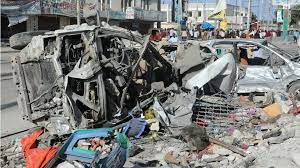By Sarah Harrison, Senior Analyst, International Crisis Group
- Through four administrations – over more than sixteen years – the U.S. government has been engaged in military operations against Al-Shabaab, a jihadist insurgency in Somalia. Today, the East African country continues to be a focal point of the U.S.’s war on terror
The U.S. government’s objective in Somalia is to contain the jihadist insurgency Al-Shabaab. To achieve this, the U.S. uses airstrikes against the group and trains an elite Somali special operations unit known as the “Danab” to conduct ground operations.
The U.S. legacy of counterterrorism in Somalia stretches across four administrations.
During the Bush administration in the early 2000s, U.S. officials were preoccupied with Iraq and Afghanistan. The Central Intelligence Agency (CIA) filled a policy void, paying warlords to find and capture members of al-Qaeda in Somalia. The author of a well-known State Department dissent cable argued that the CIA approach was futile and predicted the rise of Islamic militias.
In late 2006 and early 2007, the U.S. backed Ethiopia’s effort to depose the Islamic Courts Union (ICU) – a group of Islamist clerics that had gained control of Mogadishu – including its emerging “enforcement wing” Al-Shabaab. Both the U.S. and Ethiopia feared extremists in the ICU’s ranks.
The relatively short operation created an even greater security vacuum in central and southern Somalia. ICU civilian leadership fled Somalia and Al-Shabaab initiated an insurgency. In February 2007, just weeks after the ICU fell, the UN Security Council authorized an African Union force (AMISOM) to restore security. AMISOM shouldered most of the effort to counter and beat back Al-Shabaab with some success until roughly 2015. But its performance, and that of its successor mission, flagged as it became bogged down holding captured territory.

A Ugandan military sniper with AMISOM watches for Al-Shabaab militants from the control tower at Baledogle Airfield in 2012AMISOM
President Obama picked up the mantle in 2009, initially seeking to limit U.S. military involvement, but over time expanding both military operations and the legal theory under which they were conducted.
During his first term (2009-2013), President Obama did not send forces into Somalia, but responded to threat perceptions with military assistance to Somalia and airstrikes against senior Al-Shabaab leaders it deemed to be members of Al-Qaeda and therefore targetable under U.S. law. The U.S. also provided weapons and training to AMISOM troop contributing countries.
During Obama’s second term (2013-2017), U.S. threat perceptions increased, and its military engagement deepened. In 2013, Obama sent a small contingent of U.S. troops to advise and train the Danab. The administration also increased the tempo of strikes on Al-Shabaab and ultimately deemed the group as an “associated force” of Al-Qaeda. This meant that the U.S. government had decided it could lawfully strike anyone in Al-Shabaab based on their membership in the group.
The Baledogle Air Base

Planet Labs | Mapcreator
The Baledogle Air Base – the entrance to which Al-Shabaab struck in 2019 – is approximately 100 kilometers northwest of Mogadishu. Originally, the Soviet Union helped the Somali military build the base. Due to the country’s chronic instability and changes in power, Baledogle has been dominated by Somali state forces, warlords, Al-Shabaab, and international forces. AMISOM captured the base in 2012 and U.S. forces began training the Danab there in 2014.
The Baledogle Air Base is shown here in 2013. The base and airstrip have undergone some changes since then. Due to a degrading runway in 2018, the U.S. military dedicated $12 million for emergency repairs that consisted of full-depth patching and an overlay of the runway. Other maintenance (eg, bush clearing) or upgrades (eg, building of new structures) that can be seen in these images may have been due to other U.S. or AMISOM investments.

Google Earth | Maxar Technologies

Since 2017, Baledogle’s airstrip was repaved, and a northern section of the base was further developed.Planet Labs

When President Trump came into office in 2017 he dramatically accelerated the tempo of U.S. operations in Somalia. His “gloves off” approach led his administration (2017-2021) to chalk up the highest number of recorded airstrikes in Somalia of any presidential administration, yet Al-Shabaab proved resilient.

(T) In 2019 the U.S. carried out its highest number of airstrikes (63) in a calendar year in Somalia. The number of airstrikes in 2019 alone exceeded the total (60) of airstrikes undertaken during the twelve year period that preceded it, which included both terms of the Obama administration and the second term of the Bush administration. (B) The Al-Shabaab data show how the group continued to carry out hundreds of violent events in 2019, which included a bombing at the entrance of Baledogle airfield in September. While not reflected in this chart, in the first month of the following year, Al-Shabaab conducted a complex attack against U.S. and Kenyan forces at a base in Manda Bay, Kenya on 5 January 2020.
But two months before his term ended Trump hastily shifted course. He directed U.S. forces to reposition out of Somalia. AFRICOM followed the letter of the order, removing troops from the country, but it found an ambiguity in Trump’s order, which did not end the counterterrorism mission. It continued to send forces back into Somalia on a rotational basis to train the Danab.
AFRICOM’s Commander, General Stephen Townsend, was strongly supportive of a persistent force in Somalia and asserted that Al-Shabaab, al-Qaeda’s strongest affiliate, posed a threat to the U.S. homeland—a minority view within the U.S. government. The Defense Department backed him up, with many agreeing that U.S. troops should continue to contain the threat posed by Al-Shabaab. Officials at the State Department and at the National Security Council were similarly aligned and offered no meaningful resistance to sending forces back: they considered such a move to be a low-cost, low-risk endeavour that would have at least some positive effect.
In May of 2022 President Biden made his decision to reverse Trump’s directive. He signed off on a few hundred U.S. forces to go back to Somalia on a persistent basis and also authorized the specific targeting of about a dozen Al-Shabaab leaders.
But questions remain. Washington’s approach seeks to contain the threat posed by Al-Shabaab at present, but is not linked to a broader strategy for managing it over the long term. This approach might make sense if Washington intended to remain in Somalia forever, but Mogadishu cannot bank on that, and neither should U.S. policymakers. Absent a wider political strategy, “putting Somalia in a box”—as one U.S. official described it—runs the risk of continuing a lopsided military approach to a conflict that requires other solutions.
Policy Recommendations
The U.S. is walking a difficult line in Somalia, but there are better alternatives to its current approach.
A more balanced U.S. policy would place a higher priority on supporting Somalia’s stabilisation efforts and, in that vein, efforts to achieve reconciliation at all levels of Somali society and government.
To create a better-informed public debate, relevant committees in Congress should schedule hearings about U.S. policies and objectives in Somalia and also help shape a more balanced U.S. policy by appropriating more money for non-military lines of efforts.
In the long term, reconciliation efforts might also include negotiations with Al-Shabaab. While those talks would be Somali-led, the U.S. can prepare itself for the possibility, and signal to Mogadishu that when the time is right, it will not stand in their way.
@International Crisis Group, https://www.crisisgroup.org/content/us-containment-strategy-somalia





